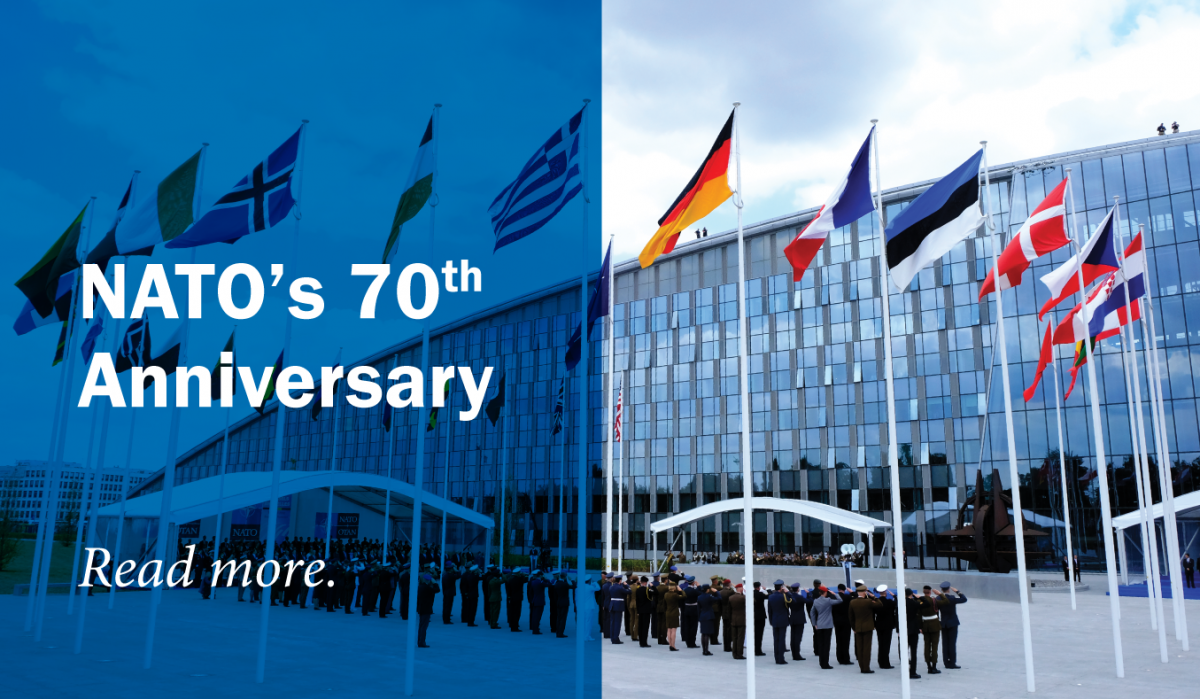Still in the U.S. Enlightened Self-Interest
"One could easily depict the current situation only in dire terms, focusing on points of disagreement. Yet this misses the whole picture, including areas of renewed energy." –Derek Chollet
 Forged in the smoldering rubble of the Second World War, NATO demonstrates its value every day—from advancing shared security interests to acting as a force-multiplier for Western democracies. But, on the eve of its 70th anniversary, internal tumult spells worry for the future.
Forged in the smoldering rubble of the Second World War, NATO demonstrates its value every day—from advancing shared security interests to acting as a force-multiplier for Western democracies. But, on the eve of its 70th anniversary, internal tumult spells worry for the future.
Unlike during the turbulences of the past—such as Cold War disputes over nuclear weapons or post-Cold War broodings over the purpose of the organization—NATO members are now worried about basic assumptions. They watch debates (and read Twitter feeds) in the United States and wonder how committed the country remains to the alliance. Amid this strife, Congress must play a more active role in affirming and bolstering U.S. leadership within NATO.
Taking a step back, one could easily depict the current situation only in dire terms, focusing on points of disagreement. Yet this misses the whole picture, including areas of renewed energy, which can be measured in at least four ways.
First, NATO is increasing its commitment to territorial defense. In 2013, the last U.S. tank left Europe as part of the post-Cold War withdrawal. Yet today, an U.S. armored brigade combat team— comprised of 3,500 personnel and 87 tanks—is deployed to Poland. Non-U.S. allies and partners are also doubling down on their own security, leading the way with contributions to NATO’s multinational initiatives such as the Very High Readiness Joint Task Force and the Enhanced Forward Presence. Finally, members are beginning to meet their spending goals. In 2014, only three spent more than 2 percent of their GDP on defense; last year, that number rose to nine countries, and by 2024, a majority of members will meet that goal.
Second, NATO continues to live up to some of its basic principles, such as the Open-Door Policy—as recently observed in the cases of Montenegro and North Macedonia.
Third, despite all the political noise regarding NATO, support among the U.S. public remains steadfast— with recent polls showing 75 percent of Americans in support of either maintaining or increasing the nation’s commitment to the organization.
Finally, member states continue to support common security efforts by contributing significant support to ongoing missions. This includes those in places like Afghanistan, where allies and partners contribute nearly half the 17,000 troops deployed as a part of the Resolute Support Mission.
NATO continues to serve as a unique asset to the United States; however, it faces no shortage of challenges. From illegal occupations of sovereign nations to election meddling, geopolitical adversaries continue to test, divide, and weaken the alliance. For example, NATO fighter jets regularly scramble in the skies above the Baltic Sea—110 times in 2016 alone—to confront reckless Russian incursions. It is not just Russia that poses such challenges; so does China, whose rising political-military threat is only starting to garner greater attention among European countries.
Other challenges include emerging cyber and hybrid threats, which evolve at a rate faster than NATO’s ability to respond. Furthermore, the organization’s southern flank increasingly suffers from instability rooted in violent extremism, state failure, and refugee flows.
The last and perhaps most difficult challenge stems from internal tensions that undermine alliance unity. As NATO stands for common values as much as armaments and military capabilities, rising authoritarianism and nationalist politics test the very core of the Washington Treaty, which extols the “principles of democracy, individual liberty and the rule of law.” In turn, this makes it harder to maintain unity and threatens the alliance’s commitment to serve as a sentinel of liberal values. Finally, many member states are wondering whether the United States would fulfill its commitment to collective defense.
Since the United States’ support for NATO is so crucial, Congress must play an increased role in maintaining U.S. leadership within the alliance. For example, it must fund U.S. military and diplomatic efforts in Europe. The $6.5 billion European Deterrence Initiative was an important step—yet the Trump administration’s latest budget with its proposal to cut these resources, and with further cuts likely to finance the border wall with Mexico, is concerning. Members of Congress must also step in as informal ambassadors by travelling to Europe and showing support for NATO while also pressing for its continued reforms. Members can also buttress the alliance by passing bipartisan bills—such as the NATO Support Act— that reaffirm the United States’ basic commitment to it and make it harder for any president to reduce this.
Congress’ current role in rekindling the spirit that energizes U.S. leadership in NATO is not a new one. Almost 68 years ago, a similar debate gripped Washington, and specifically the U.S. Congress. In early 1951, many major political figures doubted the wisdom of NATO, claiming that deploying U.S. troops to Europe was not in the nation’s best interest. It fell to General Dwight Eisenhower to come out of retirement and galvanize support for sending troops to Europe. In February 1951, just before he took command as NATO’s first supreme commander, he came to Capitol Hill to make his case before both chambers of Congress. He passionately and successfully argued for what he called the “enlightened self-interest” of U.S. leadership in NATO.
Eisenhower’s words ring prescient today, when domestic politics echo similar doubts about the NATO’s value to U.S. interests, because if the alliance did not exist the United States would be racing to invent it.
This essay is based on the author’s testimony before the U.S. House Foreign Affairs Committee, March 14, 2019.
Read the full publication »
Photo Credit: Aleks_Shutter / Shutterstock